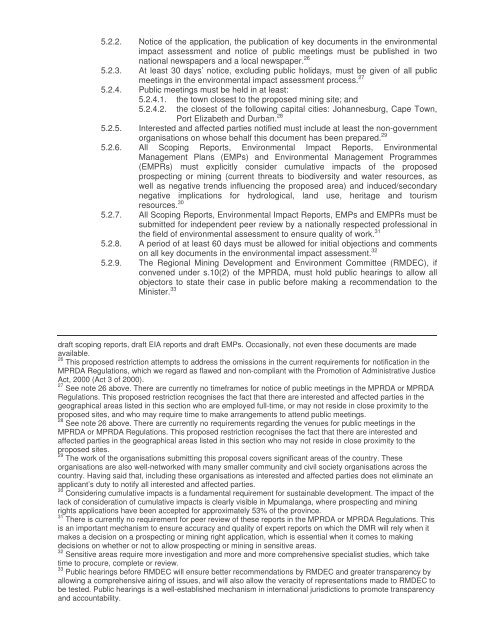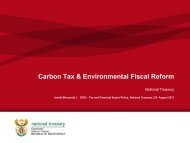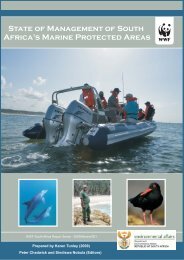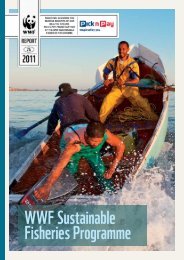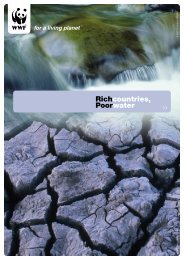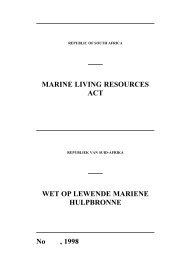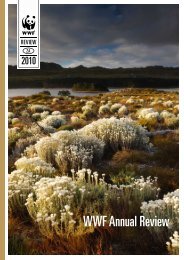CER Letter to Minister Shabangu re MPRDA s49 - 1 Feb 2011
CER Letter to Minister Shabangu re MPRDA s49 - 1 Feb 2011
CER Letter to Minister Shabangu re MPRDA s49 - 1 Feb 2011
Create successful ePaper yourself
Turn your PDF publications into a flip-book with our unique Google optimized e-Paper software.
5.2.2. Notice of the application, the publication of key documents in the environmental<br />
impact assessment and notice of public meetings must be published in two<br />
national newspapers and a local newspaper. 26<br />
5.2.3. At least 30 days’ notice, excluding public holidays, must be given of all public<br />
meetings in the environmental impact assessment process. 27<br />
5.2.4. Public meetings must be held in at least:<br />
5.2.4.1. the <strong>to</strong>wn closest <strong>to</strong> the proposed mining site; and<br />
5.2.4.2. the closest of the following capital cities: Johannesburg, Cape Town,<br />
Port Elizabeth and Durban. 28<br />
5.2.5. Inte<strong>re</strong>sted and affected parties notified must include at least the non-government<br />
organisations on whose behalf this document has been p<strong>re</strong>pa<strong>re</strong>d. 29<br />
5.2.6. All Scoping Reports, Environmental Impact Reports, Environmental<br />
Management Plans (EMPs) and Environmental Management Programmes<br />
(EMPRs) must explicitly consider cumulative impacts of the proposed<br />
prospecting or mining (cur<strong>re</strong>nt th<strong>re</strong>ats <strong>to</strong> biodiversity and water <strong>re</strong>sources, as<br />
well as negative t<strong>re</strong>nds influencing the proposed a<strong>re</strong>a) and induced/secondary<br />
negative implications for hydrological, land use, heritage and <strong>to</strong>urism<br />
<strong>re</strong>sources. 30<br />
5.2.7. All Scoping Reports, Environmental Impact Reports, EMPs and EMPRs must be<br />
submitted for independent peer <strong>re</strong>view by a nationally <strong>re</strong>spected professional in<br />
the field of environmental assessment <strong>to</strong> ensu<strong>re</strong> quality of work. 31<br />
5.2.8. A period of at least 60 days must be allowed for initial objections and comments<br />
on all key documents in the environmental impact assessment. 32<br />
5.2.9. The Regional Mining Development and Environment Committee (RMDEC), if<br />
convened under s.10(2) of the <strong>MPRDA</strong>, must hold public hearings <strong>to</strong> allow all<br />
objec<strong>to</strong>rs <strong>to</strong> state their case in public befo<strong>re</strong> making a <strong>re</strong>commendation <strong>to</strong> the<br />
<strong>Minister</strong>. 33<br />
draft scoping <strong>re</strong>ports, draft EIA <strong>re</strong>ports and draft EMPs. Occasionally, not even these documents a<strong>re</strong> made<br />
available.<br />
26 This proposed <strong>re</strong>striction attempts <strong>to</strong> add<strong>re</strong>ss the omissions in the cur<strong>re</strong>nt <strong>re</strong>qui<strong>re</strong>ments for notification in the<br />
<strong>MPRDA</strong> Regulations, which we <strong>re</strong>gard as flawed and non-compliant with the Promotion of Administrative Justice<br />
Act, 2000 (Act 3 of 2000).<br />
27 See note 26 above. The<strong>re</strong> a<strong>re</strong> cur<strong>re</strong>ntly no timeframes for notice of public meetings in the <strong>MPRDA</strong> or <strong>MPRDA</strong><br />
Regulations. This proposed <strong>re</strong>striction <strong>re</strong>cognises the fact that the<strong>re</strong> a<strong>re</strong> inte<strong>re</strong>sted and affected parties in the<br />
geographical a<strong>re</strong>as listed in this section who a<strong>re</strong> employed full-time, or may not <strong>re</strong>side in close proximity <strong>to</strong> the<br />
proposed sites, and who may <strong>re</strong>qui<strong>re</strong> time <strong>to</strong> make arrangements <strong>to</strong> attend public meetings.<br />
28 See note 26 above. The<strong>re</strong> a<strong>re</strong> cur<strong>re</strong>ntly no <strong>re</strong>qui<strong>re</strong>ments <strong>re</strong>garding the venues for public meetings in the<br />
<strong>MPRDA</strong> or <strong>MPRDA</strong> Regulations. This proposed <strong>re</strong>striction <strong>re</strong>cognises the fact that the<strong>re</strong> a<strong>re</strong> inte<strong>re</strong>sted and<br />
affected parties in the geographical a<strong>re</strong>as listed in this section who may not <strong>re</strong>side in close proximity <strong>to</strong> the<br />
proposed sites.<br />
29 The work of the organisations submitting this proposal covers significant a<strong>re</strong>as of the country. These<br />
organisations a<strong>re</strong> also well-networked with many smaller community and civil society organisations across the<br />
country. Having said that, including these organisations as inte<strong>re</strong>sted and affected parties does not eliminate an<br />
applicant’s duty <strong>to</strong> notify all inte<strong>re</strong>sted and affected parties.<br />
30 Considering cumulative impacts is a fundamental <strong>re</strong>qui<strong>re</strong>ment for sustainable development. The impact of the<br />
lack of consideration of cumulative impacts is clearly visible in Mpumalanga, whe<strong>re</strong> prospecting and mining<br />
rights applications have been accepted for approximately 53% of the province.<br />
31 The<strong>re</strong> is cur<strong>re</strong>ntly no <strong>re</strong>qui<strong>re</strong>ment for peer <strong>re</strong>view of these <strong>re</strong>ports in the <strong>MPRDA</strong> or <strong>MPRDA</strong> Regulations. This<br />
is an important mechanism <strong>to</strong> ensu<strong>re</strong> accuracy and quality of expert <strong>re</strong>ports on which the DMR will <strong>re</strong>ly when it<br />
makes a decision on a prospecting or mining right application, which is essential when it comes <strong>to</strong> making<br />
decisions on whether or not <strong>to</strong> allow prospecting or mining in sensitive a<strong>re</strong>as.<br />
32 Sensitive a<strong>re</strong>as <strong>re</strong>qui<strong>re</strong> mo<strong>re</strong> investigation and mo<strong>re</strong> and mo<strong>re</strong> comp<strong>re</strong>hensive specialist studies, which take<br />
time <strong>to</strong> procu<strong>re</strong>, complete or <strong>re</strong>view.<br />
33 Public hearings befo<strong>re</strong> RMDEC will ensu<strong>re</strong> better <strong>re</strong>commendations by RMDEC and g<strong>re</strong>ater transpa<strong>re</strong>ncy by<br />
allowing a comp<strong>re</strong>hensive airing of issues, and will also allow the veracity of <strong>re</strong>p<strong>re</strong>sentations made <strong>to</strong> RMDEC <strong>to</strong><br />
be tested. Public hearings is a well-established mechanism in international jurisdictions <strong>to</strong> promote transpa<strong>re</strong>ncy<br />
and accountability.


